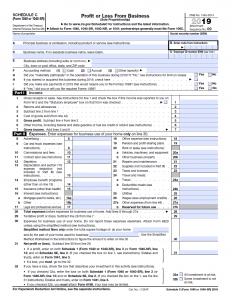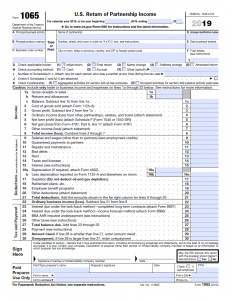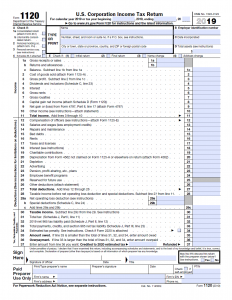Preparing and filing your business tax returns is an important step for any business. But your business tax returns are also vitally important in building business credit.
Although the Federal government has many forms and schedules you will need to complete over the course of a year, there are three key documents, depending on how your business is structured.
 Business Tax Returns using Schedule C
Business Tax Returns using Schedule C
Use Schedule C (Form 1040 or 1040-SR) to report income or (loss) from a business you operated or a profession you practiced as a sole proprietor.
There are five parts of Schedule C. The main parts are Part I: Income and Part II: Expenses. Parts III: Cost of Goods Sold, IV: Vehicle Information and V: Other Expenses provide additional detail to support Parts I & II.
Just below Section II, you summarize your results and calculate your net income or loss. This is where you have big decisions to make regarding your business tax returns as it relates to building business credit.
From a tax perspective, you want to minimize your income or perhaps even present a loss. You want to send as little as possible to Uncle Sam and your state’s Department of Revenue.
But when it comes to building business credit and getting business financing, you do want to show a profit. If you show losses year after year, it is very difficult to get approved for business financing, which of course impedes your ability to build business credit.
 Business Tax Returns using Form 1065
Business Tax Returns using Form 1065
Form 1065 is an information return used to report the income, gains, losses, deductions, credits, and other information from the operation of a partnership.
A partnership doesn’t pay tax on its income but passes through any profits or losses to its partners. Partners must include partnership items on their tax or information returns.
Form 1065 appears simple and easy at the start – you report your income, expenses, tax and payment information. But when you look deeper at Form 1065, it is much more complicated:
- Schedule B: Additional Information consists of 25 questions
- Schedule K: Partner Distribution calculations
- Schedule L: Balance Sheet
- Schedule M-1: Income Statement Reconciliation
- Schedule M-2: Partner Capital Account Analysis
You will definitely want to work through this form with your Accountant/CPA. Your CPA will most likely be looking at your financial situation from a tax perspective to minimize your income or perhaps even present a loss. That’s good – they should be looking to minimize your tax obligations.
But don’t let them forget your financial situation also includes building business credit and getting business financing. Encourage your CPA to consider showing a profit.
If your CPA is obsessed with showing losses year after year, it is very difficult to get approved for business financing, which of course impedes your ability to build business credit.
 Business Tax Returns using Form 1120
Business Tax Returns using Form 1120
Form 1120, U.S. Corporation Income Tax Return, is used to report the income, gains, losses, deductions, credits, and to figure the income tax liability of a corporation.
Unless exempt under section 501, all domestic corporations must file an income tax return whether or not they have taxable income.
If an entity with more than one owner was formed as an LLC under state law, it generally is treated as a partnership for federal income tax purposes and files Form 1065, U.S. Return of Partnership Income.
Generally, a single-member LLC is disregarded as an entity separate from its owner and reports its income and deductions on its owner’s federal income tax return. The LLC can file a Form 1120 only if it has filed Form 8832 to elect to be treated as an association taxable as a corporation.
Much like Form 1065, Form 1120 appears simple and easy at the start – you report your income, expenses, tax and payment information. But when you look deeper at Form 1120, it too is much more complicated:
- Schedule C: Dividends
- Schedule J: Tax Calculations
- Schedule K: Other Information
- Schedule L: Balance Sheet
- Schedule M-1: Income Statement Reconciliation
- Schedule M-2: Retained Earnings Analysis
Form 1120 is not for amateurs – you will want to engage the professional advice of your Accountant/CPA to develop your business and personal strategy related to double taxation.
Double taxation is a term used to describe the way taxes are imposed on corporate shareholders and on corporations. The corporation is taxed on its earnings (profits), and the shareholders are taxed again on the dividends they receive from those earnings.
Due to the double taxation of corporations, your CPA may be very motivated to minimize your income or perhaps even present a loss. But again, don’t let them forget your financial situation also includes building business credit and getting business financing. Encourage your CPA to consider showing a profit.
Hopefully you have found this information on business tax returns helpful. But please don’t consider this tax advice – always check with your Accountant/CPA before making important tax decisions for your business.
When you are ready to begin building business credit by getting business financing, having your business tax returns properly prepared will go a long way to getting more business capital at lower rates with longer terms.


